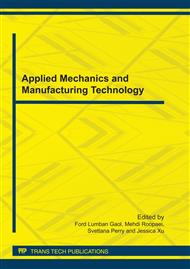[1]
Tsai M. Y., Hsu C. H., and Han C. N. (2004) A note on Suhir's Solution of Thermal Stresses for a Die-Substrate Assembly: Journal of Electronic Packaging., (2004), Vol. 126, pp.115-119.
DOI: 10.1115/1.1648056
Google Scholar
[2]
Timoshenko. S. (1925). Analysis of Bi-Metal Thermo-stats., J. Opt. Soc. Am. 11, p.233.
Google Scholar
[3]
Suhir E. (1986). Stresses in Bimetal Thermostats, Journal of Applied Mechanics, Vol. 53, p.657.
Google Scholar
[4]
Suhir E. (1989). Interfacial Stresses in Bimetal Thermostats, ASME J. Appl. Mech. Vol. 56, p.595.
DOI: 10.1115/1.3176133
Google Scholar
[5]
Sujan D., Seetharamu K. N., Hassan A. Y., and Murthy M. V. V. (2004). Engineering Model for Interfacial stresses of a heated bimaterial Structure Used in Electronic Packaging, 6th EMAP, Penang, Malaysia, pp.181-187.
DOI: 10.4071/1551-4897-2.2.132
Google Scholar
[6]
Sujan D., Murthy M. V. V., Seetharamu K. N., and Hassan A. Y. (2005).
Google Scholar
[7]
Matthys L. and Mey G. D. (1996)., An analysis of an Engineering model for the Thermal Mismatch Stresses at the Interface of a Uniformly Heated Two Layer Structure, The International Journal of Electronic Packaging., Vol. 19, No. 3, p.323.
Google Scholar
[8]
Mirman I. B. (1991). Effects of Peeling Stresses in Bimaterial Assembly, ASME Journal of Electronic Packaging 1, p.431.
DOI: 10.1115/1.2905433
Google Scholar
[9]
Moore. T. D. and Jarvis. J. L. (2003). A Simple and Fundamental Design Rule for Resisting Delamination in Bimaterial Structures., Microelectron Reliab. 43, p.487.
DOI: 10.1016/s0026-2714(02)00317-7
Google Scholar
[10]
Moore. T. D. and Jarvis. J. L. (2004). The Peeling Moment A Key Rule for Delamination Resistance in I.C. Assemblies, Vol. 126, p.106.
DOI: 10.1115/1.1649240
Google Scholar
[11]
Ru. C.Q. (2002). Interfacial Thermal Stresses in Bimaterial Elastic Beams: Modified Beam Models Revisited., ASME Journal of Electronic Pacaging., 124(3), p.141.
DOI: 10.1115/1.1481037
Google Scholar
[12]
Brown W. D. (1999). Advanced Electronic Packaging. IEEE Press, p.241.
Google Scholar


